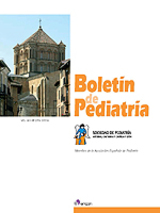Neuroprotección con hipotermia terapéutica en la encefalopatía hipóxico-isquémica en pediatría
F. Gómez , C. Vega , A. Mirás , J. Arnáez
Bol. Pediatr. 2014; 54 (229): 148 - 155
La neuroprotección con hipotermia terapéutica en el neonato con encefalopatía hipóxico-isquémica perinatal (EHI) ha demostrado reducir la muerte y la discapacidad a largo plazo. Sin embargo, fuera de la EHI perinatal la evidencia científica es todavía escasa para afirmar que el empleo de esta técnica conduce a un mejor pronóstico de aquellos niños que han sufrido una parada cardiorrespiratoria. Se están desarrollando actualmente varios estudios clínicos multicéntricos en este grupo de edad, cuyo objetivo es demostrar el efecto de la hipotermia moderada respecto a la normotermia, así como establecer la duración, profundidad de la hipotermia y ritmo de recalentamiento. A pesar de ello, es una realidad que numerosas unidades de cuidados intensivos pediátricos están realizando este tratamiento apoyándose en las últimas guías internacionales de Reanimación Cardiopulmonar que recomiendan el empleo de hipotermia terapéutica en niños, infiriendo la evidencia científica procedente de los estudios realizados en la edad adulta y neonatal. Sin embargo, para aplicar el tratamiento con hipotermia con garantía, se deben reunir algunas condiciones, como haber realizado un entrenamiento previo, estar en disposición de monitorizar adecuadamente el estado neurológico del paciente, así como conocer y ofrecer un tratamiento integral de las potenciales complicaciones secundarias a la enfermedad hipóxico isquémica.
Neuroprotection with therapeutic hypothermia in hypoxic ischemic encephalopathy in pediatrics
Neuroprotection with therapeutic hypothermia in neonates with perinatal hypoxic-ischemic encephalopathy (HIE) has shown to reduce death and disability in the long term. However, apart from perinatal HIE there is still no scientific evidence to suggest that the use of this technique leads to a better prognosis in children who have suffered a cardiac arrest. Several multicenter trials are currently under way in this age group, aiming to demonstrate effect of moderate hypothermia compared to normothermia, and set the duration, depth of hypothermia and rewarming rate.
However, it is a fact that many pediatric intensive care units are performing this treatment based on the latest international cardiopulmonary resuscitation guidelines that recommend the use of therapeutic hypothermia in children, inferring scientific evidence from studies in the adult and neonatal age.
However, to apply treatment with hypothermia, certain conditions should be reached as prior training, ability to adequately monitor the neurological status of the patient and know and provide a comprehensive treatment of potential complications secondary to hypoxic ischemic disease.
Artículo completo (PDF) (662 kb.)
- Neonatología
